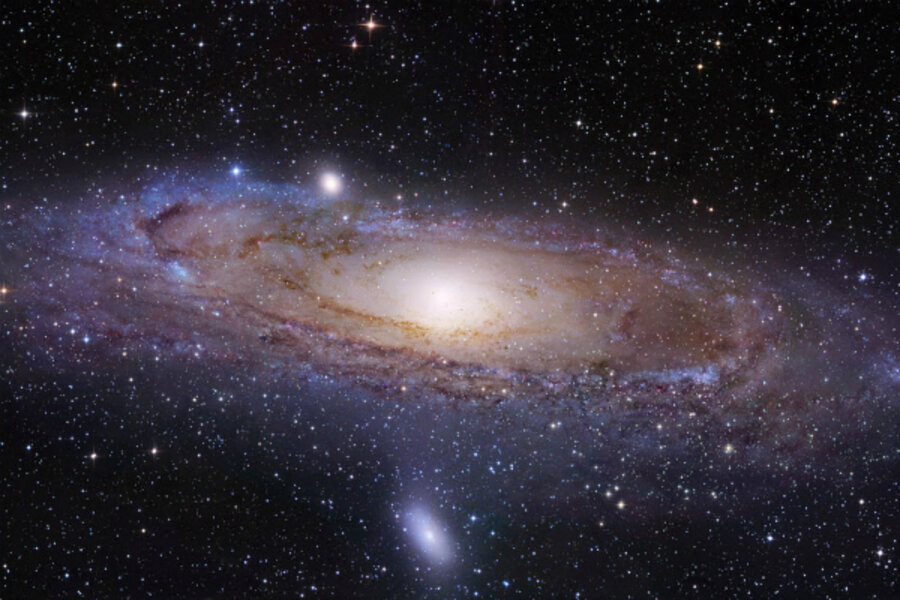Why don't spiral galaxies run out of gas? Look to the (extended) halo.
Loading...
Spiral galaxies like the Milky Way appear to host far more ordinary matter than previously estimated, according to a recent study. That may help explain why spiral galaxies in the nearby universe are still producing stars at respectable rates when, by all rights, star formation in these galaxies should have run out of gas billions of years ago.
This matter resides as gas in an extended halo nearly 1 million light-years across. For a galaxy such as the Milky Way, whose disk is roughly 100,000 light-years wide, the halo holds as much ordinary, or baryonic matter as the Milky Way's disk, with all of its stars, gas, and dust.
Moreover, this gas, much of which is expelled from the galaxy itself, appears to get recycled – returning to the galaxy to serve as the raw material for new stars and planets.
The evidence for this baryonic bonanza was gathered by an international team of astrophysicists and astronomers initially interested in some basic accounting, as well as in galaxy evolution.
Over the past decade, researchers have uncovered the recipe for the universe: 70 percent dark energy, a kind of anti-gravity that is accelerating the expansion of the universe; 25 percent dark matter, which astronomers can't see but infer because of its gravitational influence on matter astronomers can see; and ordinary, or baryonic, matter, which astronomers can see directly and exerts gravitational influence as well.
Theory suggests that the proportions of dark and baryonic matter in the universe should hold for galaxies as well. But the amount of baryonic matter astronomers detect in large spirals is only about 20 percent of what theory says should be there.
"Most of the matter is still out between the galaxies," either in a region around a galaxy where its gravity still holds sway, or beyond that in deep intergalactic space, says Michael Shull, an astrophysicist at the University of Colorado at Boulder and a member of the team, which was led by colleague John Stocke, also at the University of Colorado.
The gas is so tenuous, however,. that astronomers haven't been able to capture images of it. Instead, the team used the Hubble Space Telescope's exquisitely sensitive Cosmic Origins Spectrometer to detect the gas, using bright objects called quasars as backlights.
The quasars' light passes through the gas, producing spectra that reveal the gas's abundance, composition, and its motion and velocity.
Two years ago, another research team applied this backlighting technique to galaxies known to have quasars behind them and found evidence for the halos around 42 spiral galaxies. The team estimated that the halos held substantially more gas than the galaxies themselves did.
Dr. Stocke and colleagues took another approach. In addition to using data from 11 targeted galaxies, the team, in effect, randomly picked quasars first, then measured the halo of any galaxy that fell in between. That gave then roughly 60 more galaxies for their sample.
The earlier team, in effect, was looking for the lost car keys at night under the streetlight, Dr. Shull quips, while "we went and looked anywhere in the parking lot."
Both groups came up with similar results, he says.
Applied to the Milky Way, the results imply that the extent of the galaxy plus its halo is about twice as large as previously estimated, Shull says.
Temperatures in the halos were on the order of 1 million degrees Celsius, or 1.8 million degrees Fahrenheit. But the halo also held so-called warm clouds, which tended to populate the inner half of the halo and consisted of elements heavier than hydrogen and helium. The team estimates that the warm clouds lacked the mass to account for more than about 10 to 15 percent of the total baryonic matter spiral galaxies should have. But when the hotter halo gas was included, the books could be brought into balance.
The circumgalactic medium also is thought to play a key role in replenishing a spiral galaxy's reserves of gas for star formation, Shull explains.
The warm clouds, relatively rich in heavier elements, likely represents gas expelled from the galaxy, where stars form the heavier elements and enormous stellar explosions called supernovae eject the enriched gas into the circumgalactic medium. Some of that expelled gas doesn't move fast enough to escape the galaxy's gravitational tug and so rains back onto the galactic disk where it can help form new stars, he says.
The warm clouds that remain, however, may provide a vital service to the galaxy – cooling some of the hotter gas that surrounds it, Shull suggests. This cooled, denser gas has lost energy and so stands a better change of getting drawn in to the galactic disk to serve as additional star fodder.
The team's results appeared recently in the Astrophysical Journal.







